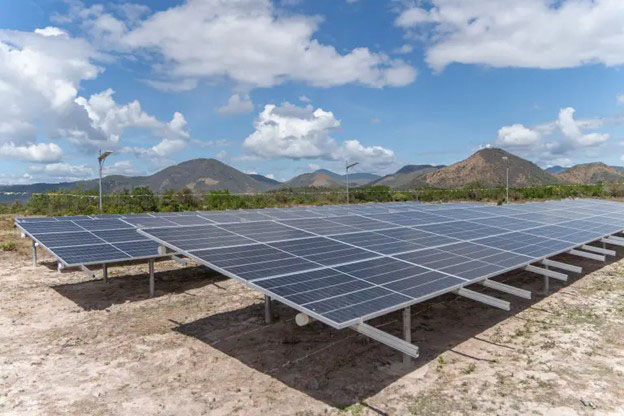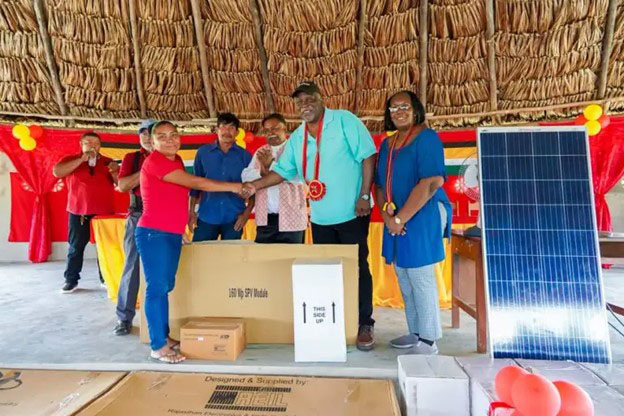The Guyana Energy Agency (GEA) said that notable milestones were achieved in 2023 from projects it undertook across all ten of Guyana’s a1dministrative regions. It said that as Guyana continues to decouple economic growth from fossil fuels for electricity generation and harnessing of its low-carbon resources, its energy progress has helped the agency to “address rising electricity demands by enhancing access to renewable energy supply across local communities”.
According to a release from the GEA, among the energy projects it has supported in hinterland and riverine communities, as of December 2023, were the supply of 26,398 of 30,000 Solar Home Energy Systems with each unit consisting of a 160-watt system to power two nine-watt LED lamps, one 12-watt stand fan, and equipped with a USB port for the charging of portable electronic devices. It added that with the completion of the 30,000 Solar photovoltaic (PV) Home Energy Systems project, a total of 4.8 MW will be installed.

Further, the GEA said that during 2023, an estimated population of 21,674 people from 3,880 households, and 262 public and community buildings in 19 communities in Regions One, Two, Seven, Eight, Nine and Ten, benefited from the installation of solar PV mini-grids. The GEA said that each solar PV mini-grid has a hybrid configuration comprising a ground-mounted solar PV array, hybrid inverter, battery energy storage system, and associated balance of system components.
The electrical network interconnects the system to the public/community buildings via a 13.8 kilovolt (kV) medium voltage transmission, and a 120/240 volts alternating current (Vac) low voltage distribution network. Combined, GEA said these mini-grids carry a total capacity of 601 kilowatt peak (KWp). Communities being supplied electricity include Baramita, Canal Bank, Haimacabra, Kwebanna, Karaburi, Sebai, Wakapoa, St Monica, Capoey, Tapakuma, Waramadong, Jawalla, Paruima, Kurukabaru, Karasabai, Aishalton, Kraudarnau, Annai, and Riversview.
GEA said it also installed two solar PV mini-grids to supply electricity to 23 buildings in Orealla and Siparuta, Region Six (East Berbice Corentyne). Orealla was equipped with a 45-kilowatt (kW) mini solar installation and a 135 kilowatt per hour (kWh) battery energy storage system, while Siparuta had a 45kW mini solar installed with a 105kWh battery energy storage system. The release noted that the government had commissioned its second 1.5 MW utility-scale solar PV plant mega-scale solar farm at Bartica, Region Seven (Cuyuni-Mazaruni) in March 2023.
At 22 off-grid locations, GEA said, over 163 kWp of solar PV capacity and 800 kWh of battery energy storage were installed at public and community buildings in 20 communities across Regions One, Two, Three, Four, Six, Seven, Nine and Ten. The 20 communities include Malborough, Siriki, Schepmoed, PlegtAnker, Baracara, Lighttown, Macushi, Muritaro, Kaikan, Aishalton, Karasabai, Georgetown, Smith Creek, Mabel Sandy, Martindale, Rockstone, Lanaballi, Bartica, Kartabo and Jawalla.
During 2023, GEA provided support to the implementation of the Small Hydropower Project (SHP) in Kumu and Moco Moco, Region Nine, which is expected to provide hydroelectricity to Lethem and its surrounding environs. A new 1.5 MW Kumu hydropower plant is being constructed and the defunct Moco Moco hydropower plant rehabilitated and upgraded to 0.7 MW capacity. The SHP, GEA said, is 37 percent completed and is scheduled for completion and commissioning by 2025.
Solar PV installation capacity across several regions was upgraded to 7.96 megawatts in 2022 with the addition of a 1-megawatt Lethem solar PV farm, ten off-grid systems at Loo Creek in Region Four, and 59 solar PV systems at public buildings. Further upgrades were added in 2023, following increases in capacity by 6.661 megawatts to 14.62 megawatts including additions of the 1.5 megawatts Bartica solar PV farm, completion of 21 solar mini-grids, 22 solar PV systems at public buildings, and distribution of 26,398 solar home energy systems.
GEA said it has installed six electric vehicle (EV) charging stations for public use in Regions Three, Four and Six to promote low-carbon infrastructure, demonstrate opportunities in the electric mobility industry and catalyze private sector replication. According to GEA, this project marked the first publicly accessible charging infrastructure along Guyana’s coast, which the agency said was a demonstration of the local market’s readiness for an electric mobility future. Additionally, 50 mechanics and auto-technicians have benefited from EV maintenance and repairs training to build capacity for the new electric vehicle industry.
The GEA said it welcomed the 2024 budget approval which includes allocations for the construction of a 0.6 MW solar farm for Leguan, completion of the 0.65 MW solar farm at Mahdia, five new solar PV mini-grids at Awarewaunau, Katoka, Maruranau, Yupukari and Nappi in Region Nine and funds for the supply and installation of off-grid solar PV systems at 42 locations. GEA said it is supportive of national efforts to transform the country’s sustainable low-carbon pathway and the energy sector to provide cleaner, affordable energy access for all, as well as promoting energy efficiency and conservation practices.






